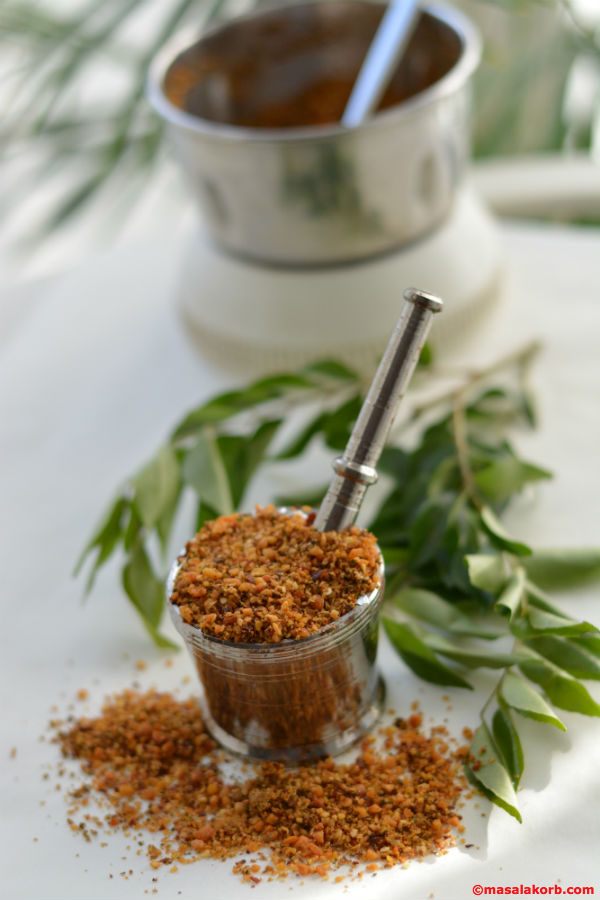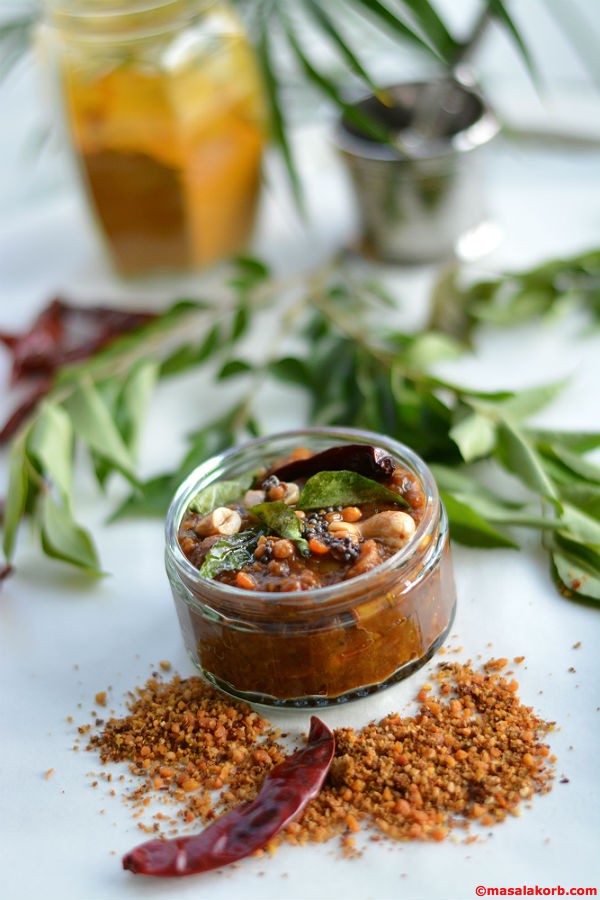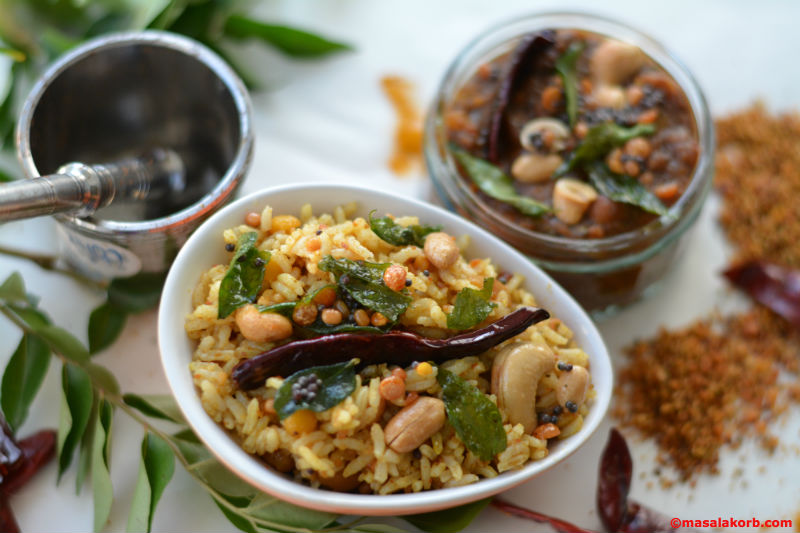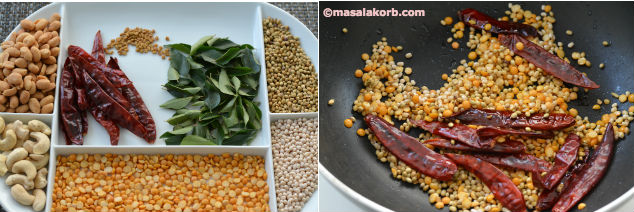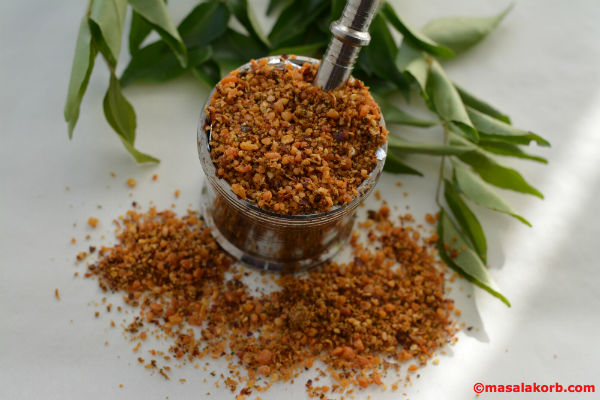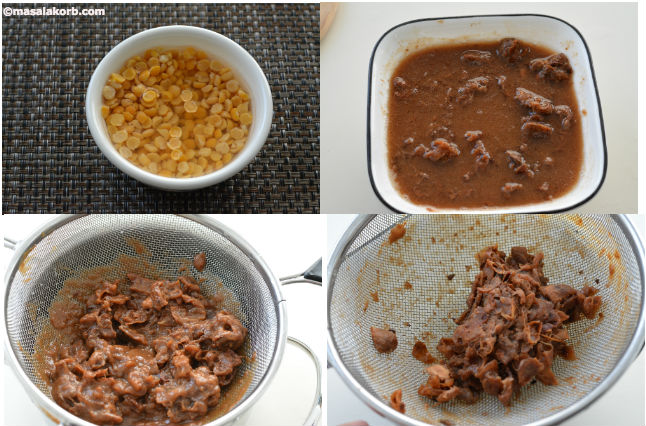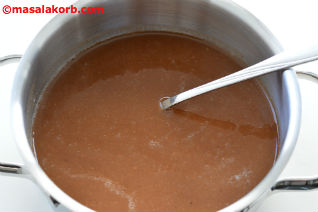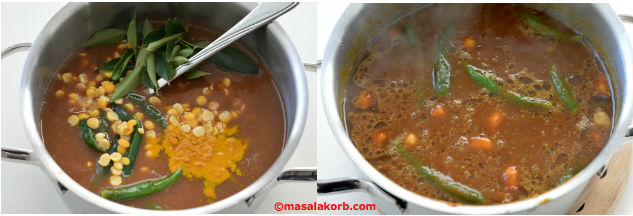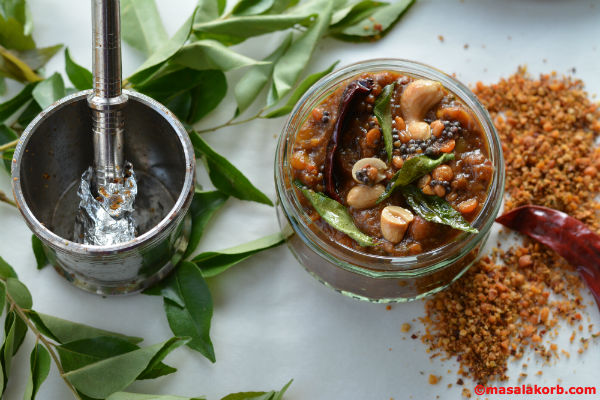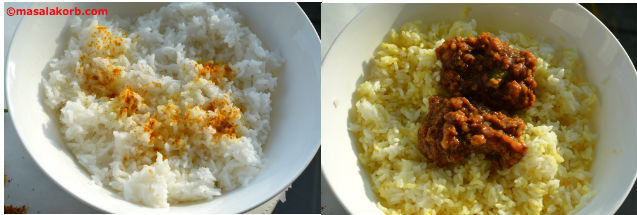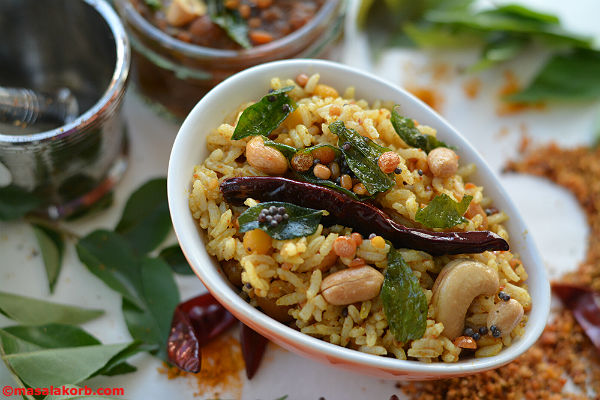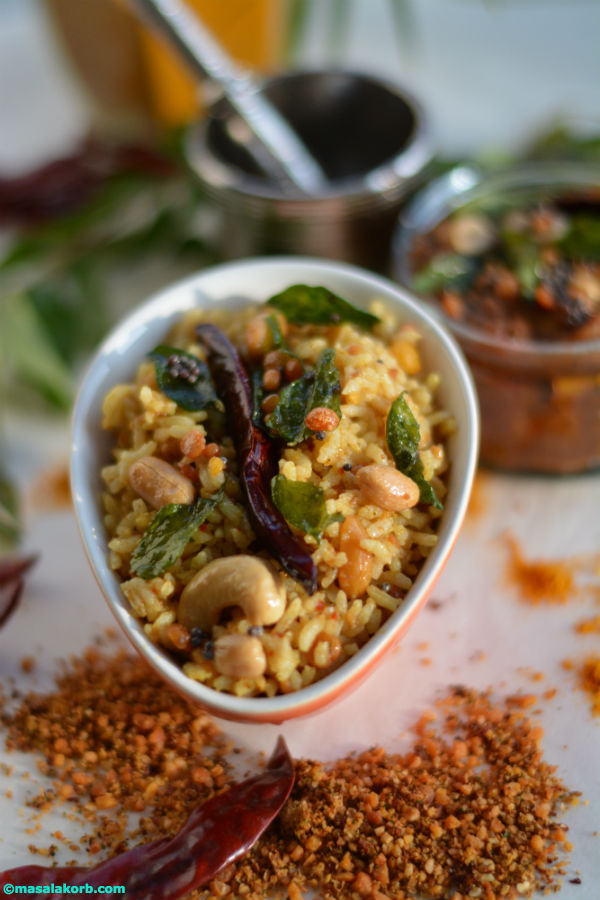Tamarind Rice or Puliyodharai Recipe | Tamilnadu Style Puliyodharai Recipe | Pulikachal Recipe – Puliyodharai rice is an authentic & traditional favourite among South Indians. It is a tangy rice speckled with various spices, lentils, nuts and aromatic curry leaves.
Editor’s note: This post was originally published in February 2015 and has been updated with new Video and the content remains unchanged.
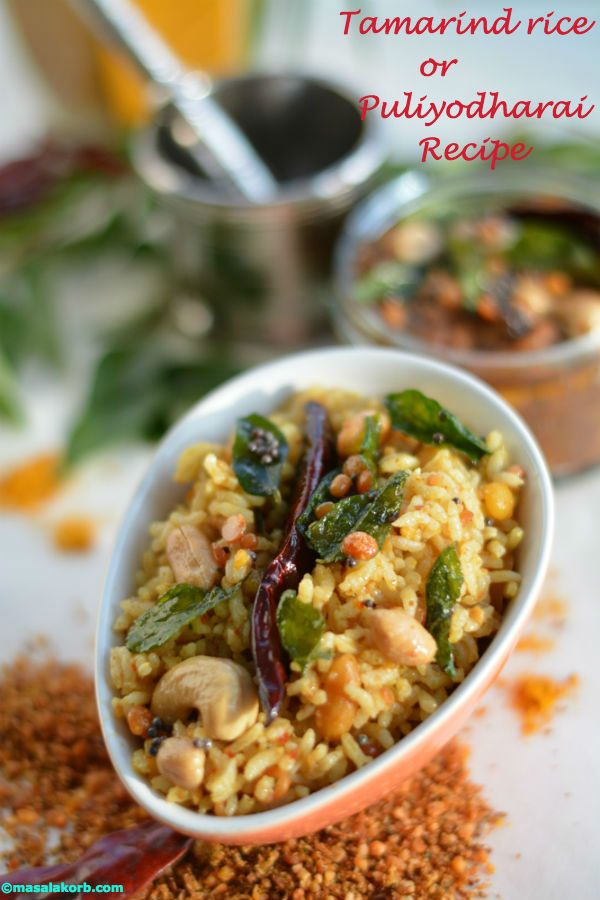 The taste of Tamarind rice or Puliyodharai Recipe depends mainly on the proportions of the ingredients. It is easy but at the same time you need to be careful when it comes to making the main tamarind paste. There are umpteen ways to prepare the tamarind paste, which forms the base for this rice preparation. There are also simple ways to make the tamarind paste, but today I decided to take the conventional path.
The taste of Tamarind rice or Puliyodharai Recipe depends mainly on the proportions of the ingredients. It is easy but at the same time you need to be careful when it comes to making the main tamarind paste. There are umpteen ways to prepare the tamarind paste, which forms the base for this rice preparation. There are also simple ways to make the tamarind paste, but today I decided to take the conventional path.
What is Puliyodharai?
Tamarind rice or Puliyodharai Recipe is one of the traditional dishes that always made its venerable and much anticipated appearance at our picnics. It is fondly associated with travel as a comfort food. Nostalgic memories come rushing in, I’m transported to a time when this rice used to be a part of every trip of ours and my children hated me for that and with a big grin always said “Oh Mom!! Not again the same rice”…..Obviously it was difficult to adapt to the food here in Germany during our initial days. But not any more…Now tamarind rice is only made either for a festive occasion, potluck, party or just when we feel like having it!! But, nothing can beat the tamarind rice or puliyodharai given in temples as prasadam, which is my all time favourite!!
Don’t be intimidated with the long list of ingredients, it looks complicated but it’s pretty simple….but I must admit; it took me quite an effort to put them all together in a single post. In the Tamarind rice or Puliyodharai Recipe making the tamarind paste is a little time consuming but when made in bulk and stored; it is handy with minimum efforts and tamarind rice can be whipped up in no time.
So here is my take on traditional tamarind rice or puliyodharai recipe, Tamilnadu style or close to temple style…I love its aroma, texture, spicy flavour and the tangy taste of the tamarind rice…..I’m sure you too will love it. Off to Tamarind rice or Puliyodharai Recipe!!
Step-By-Step process to make
Tamarind rice or Puliyodharai Recipe:
The process for Tamarind rice or Puliyodharai Recipe involves 3 main preparations –
- Spice powder
- Tamarind paste
- Tamarind rice or Puliyodharai
Spice powder for Tamarind rice or Puliyodharai Recipe:
Tamarind paste forTamarind rice or Puliyodharai Recipe:
Tamarind rice or Puliyodharai Recipe:
Note: Refer to the recipe card at the end of the post for the ingredients list and quantities.
Let’s see how to prepare each of these steps individually required for the Tamarind rice or Puliyodharai Recipe.
Making Spice Powder:
- Grab all the required ingredients to make the spice powder.
- Heat one tablespoon of oil in a pan over medium heat and roast all the ingredients under the heading “For the powder” (except asafoetida and curry leaves) until you get a nice aroma and the lentils get a nice golden brown colour.
- Finally add asafoetida and curry leaves.
- sauté till the curry leaves turn crisp and turn off the heat.
- Cool the roasted ingredients and grind to a coarse powder using a blender.
- Set aside to use it later in the tamarind paste.
Let’s make the Tamarind Paste:
- Soak split Bengal gram in hot water for about 10 minutes.
- Soak tamarind in 2 cups of hot water, squeeze and extract thick juice.
- Now add another cup of water, squeeze well and strain.
- Discard the pulp.
- To this tamarind extract, drain and add soaked bengal gram along with green chillies, oil, turmeric powder, salt and sugar.
- Bring this mixture to a boil over medium heat with occasional stirring. Use a deep sauté pan or vessel, so that the extract doesn’t spill out while boiling.
- Let the mixture reduce to 2/3rd of the quantity. This may take around 15 to 20 minutes.
- To this, add the spice powder mix prepared above.
- Let it boil for another 5 minutes with constant stirring. Turn off the heat and allow it to cool.
- For the seasoning, heat oil in a pan and add all the ingredients under the heading “For the seasoning” one after the other in the given order (except asafoetida and curry leaves). Make sure the fenugreek seeds do not burn otherwise you get a bitter taste.
- Once the mustard seeds splutter and the nuts and lentils turn golden brown, add asafoetida and curry leaves and turn off the heat.
- Transfer the seasoning to the tamarind paste and mix well. You can set aside some seasoning, as I did, to use as garnish for the tamarind rice in the next step.
- Now the Tamarind paste is ready, which can be stored for about 3 to 4 weeks in the refrigerator. If you increase the quantity of oil, it can even be stored for 2 months or even more when used with care.
Mixing Tamarind rice or Puliyodharai:
- Cook rice in the usual method. Just make sure each grain in the rice is separate. This can be obtained by cooking rice in the ratio of 1cup rice to 1½ cups of water instead of 2 cups of water.
- Spread the rice on a plate or bowl to cool. Add oil and turmeric powder when it is still warm.
- Once the rice cools down, mix gently without breaking the rice.
- Now add 2 tablespoons of the prepared tamarind paste. Mix well using your hands, so that every grain of rice is coated with the paste. Taste and check for salt. Add another spoon of paste if required.
- Garnish tamarind rice with remaining seasoning set aside.
Tip:
- Do not hurry up in adjusting salt immediately. It takes at least 30 minutes for the rice to imbibe all the flavours after combining with the tamarind paste. Be patient and check salt after sometime. You can also add some more tamarind paste if you want it more spicy or tangy. It’s purely personal choice, how you want your tamarind rice or puliyodharai to taste. But I must tell you, tamarind rice tastes best after sitting for a couple of hours from the time of preparation or even better the next day.
- Note: I’m not using up all the tamarind paste that I prepared. I made it in bulk so that I can store it to use for the lazy days when I’m not in the mood to cook. The measurements given above for the tamarind rice are for 2 cups of cooked rice. Store the remaining tamarind paste in refrigerator.
- Serve with potato chips or potato fry. For all the carnivores out there try it with chicken curry or chicken fry….trust me, it tastes heavenly
 .
.
Tamarind Rice - Tamilnadu Style Puliyodharai
Ingredients
For the spice Powder:
- 1 tbsp Oil
- 15 Dry Red Chillies
- ½ Cup Chana Dal
- ¼ Cup Urad Dal
- ½ tsp Fenugreek Seeds
- ½ Cup Coriander Seeds
- ½ tsp Asafoetida
- Handful of Curry Leaves
For the Tamarind paste:
- ¼ Cup Chana Dal Soaked in hot water for 10 minutes
- 3 Cups Thick Tamarind Juice Extracted from 150 grams Tamarind
- 8 Green Chillies Slit in half
- 1 tbsp Oil
- ½ tsp Turmeric Powder
- 2 tsp Salt Adjust to your taste
- 2 tsp Jaggery/Sugar
For the seasoning:
- 4 tbsp Oil
- ¼ tsp Fenugreek Seeds
- 1 tsp Mustard Seeds
- 2 tbsp Chana Dal
- 1 tbsp Urad Dal
- 5 Dry Red Chillies
- 10 Cashew Nuts
- ½ Cup Peanuts
- ½ tsp Asafoetida
- Handful of Curry Leaves
For the Tamarind rice:
- 2 Cups Cooked Rice Sona Masoori rice
- 1 tbsp Oil
- ½ tsp Turmeric Powder
- 2 to 3 tbsp of the above prepared tamarind paste
- Salt only if necessary check after mixing the paste & add
Instructions
For the Spice Powder:
- Heat oil in a pan over medium heat and roast all the ingredients under the heading “For the powder” (except asafoetida and curry leaves) until you get a nice aroma and the lentils turn golden brown colour.
- Finally add asafoetida, curry leaves and sauté till the curry leaves are crispy.
- Turn off the heat and cool the roasted ingredients.
- Grind the roasted ingredients to a coarse powder using a blender. Set aside to use later.
For the Tamarind Paste
- Soak split Bengal gram in hot water for about 10 minutes.
- Soak tamarind in 2 cups of hot water and extract thick juice.
- Now add another cup of water and squeeze well. Strain the juice using a strainer and discard the pulp.
- To this tamarind extract, drain and add soaked bengal gram along with green chillies, oil, turmeric powder, salt and sugar.
- Bring this mixture to a boil over medium heat with occasional stirring.
- Let the mixture reduce to 2/3rd of the quantity. This may take around 15 to 20 minutes.
- To this, add the spice powder mix. Let it boil for another 5 minutes. Turn off the heat.
For the Seasoning
- Heat oil in a pan and add all the ingredients under the heading “For the seasoning” one after the other in the given order (except asafoetida and curry leaves). Once the mustard seeds splutter and the nuts and lentils turn golden brown, add asafoetida and curry leaves and turn off the heat. Transfer the seasoning to the tamarind paste and mix well.
For Tamarind rice:
- Spread the cooked rice on a plate/bowl to cool. Add oil and turmeric powder when it is still warm. Once the rice cools down, mix gently without breaking the rice.
- Now add 2 Tablespoons of the prepared tamarind paste. Mix well using your hands, so that every grain of rice is coated with the tamarind paste. Add one more tablespoon of the paste if required.
- It takes at least 30 minutes for the rice to imbibe all the flavours after combining with the tamarind paste.
- Adjust salt. You can also add some more tamarind paste if you want it more spicy or tangy.
- Serve with potato chips or potato fry.
Recipe Video
Notes
- You can adjust spice levels with the tamarind paste or you can reduce or increase dry red chillies in the spice powder preparation or green chillies in the tamarind paste preparation.
- The tamarind paste can be stored for 3 to 4 weeks in the refrigerator and used when required. You can store even longer by increasing the quantity of oil.
- You can prepare the seasoning for the whole paste or in small quantities as and when you make the tamarind rice. The seasoning quantity given above is for the whole paste.
- It takes at least 30 minutes for the rice to imbibe all the flavours after combining with the mixture. Give that time before serving.
You may also like other festival recipes like Chakkara pongal, Ven Pongal and many more.
Do check out FESTIVAL RECIPES , RICE RECIPES, ONE POT MEALS and other PULIHORA RECIPES from blog.
- PULIYODHARAI RECIPE (TAMILNADU STYLE)
- LEMON RICE RECIPE (NIMMAKAYA PULIHORA)
- MAMIDIKAYA PULIHORA (RAW MANGO RICE)
Many more to come!!…..STAY TUNED!!
Hungry for more? Never miss a recipe!!…Subscribe to MasalaKorb and have posts delivered straight to your inbox! And connect with me on Facebook, Google, Twitter, Instagram and Pinterest for all of the latest updates.
Do subscribe to my YouTube Channel for latest video alerts!!
Happy Cooking 🙂
Cheers!!
Padma.

